How Flowers Are Formed
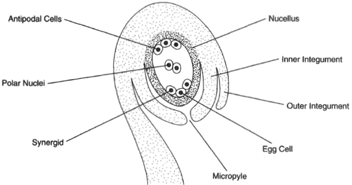 |
| Figure 35-1 The female gametophyte in an ovule. |
A flower is made of modified leaves. When a plant reaches a certain stage of
maturity, something happens that causes the plant to stop making ordinary
leaves and start producing the modified leaves that we recognize as flowers.
Specifically, the
internodes do not elongate. Thus, several whorlasr e crowded
together and inserted on an expanded receptacle. As mentioned previously
there are four whorls: the sepals (which compose the calyx), the petals (which
compose the corolla), the stamens (also called
androecium, meaning “male
house”), and the
carpels (also collectively called the pistil). At the base of the
pistil is the ovary, which bears ovules. Another name for this structure is
gynoecium (meaning “female house”).
Although the flower is part of the sporophyte generation, it is a common
practice to refer to the pistil as the female part of the flower because the
female gametophyte develops in the ovules that reside in the ovary. In like
manner, it is common to refer to the stamens as the male part of the flower
because pollen grains develop into male gametophytes. Megaspores, which
are produced in the ovule, represent the culmination of the sporophyte generation.
One of the megaspores develops into the female gametophyte.
Microspores are produced in anthers and grow into pollen grains, which, in
turn, develop into male gametophytes.
The pistil, composed of one or more carpels (modified leaves), has three
parts: the expanded ovary at the base (which bears ovules), the elongated
style, and a sticky stigma at the tip of the style (which is receptive to pollen
grains). A cross section of an ovary (figure 35-2b) reveals one to several chambers,
called locules. The ovules reside in these chambers and are attached to
the ovary wall. The place of attachment is the placenta. A cross section of an
anther (figure 35-2a) reveals chambers that contain the microspore mother
cells. These cells undergo meiosit so produce the microspores, which become
pollen grains (figure 35-3).
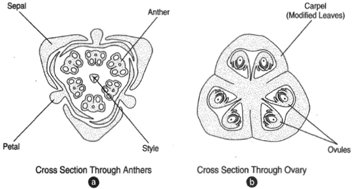 |
| Figure 35-2 (a) Cross section of a flower bud through the region of the anthers, which
contains a sepal (part of the calyx), petal (part of the corolla), anther, and style. (b) Cross
section of an ovary consisting of three carpels, each of which contains two ovules. |
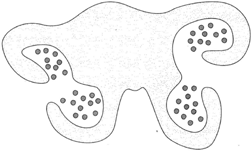 |
| Figure 35-3 Cross section of an anther, showing pollen grains. |
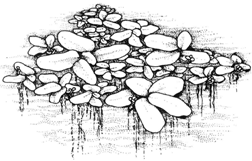 |
| Figure 35-4 Two species of duckweed, minute flowering plants that float on water. |
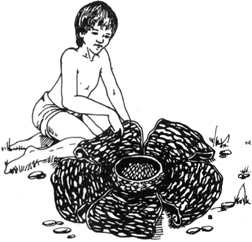 |
Figure 35-5 Rafnesia, a leafless parasitic plant. The flower can measure one meter in
diameter. It is malodorous and, thus, attracts camon-eating beetles. (Illustratiobny Donna
Mariano).
|









